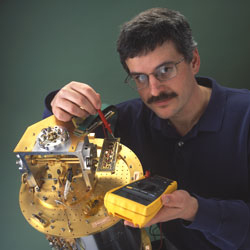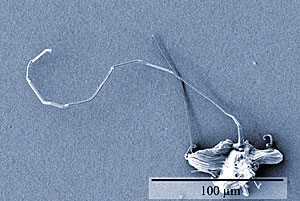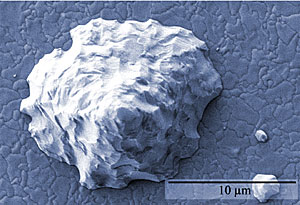| Nov.
17, 2005

[NIST
Tech Beat Search] [Credits] [NIST Tech Beat
Archives] [Media
Contacts] [Subscription Information]

Additives May Save Energy
for Cooling Big Buildings (Amended 11/22/2005)
 |
NIST
laboratory experiments have demonstrated that adding small
amount of additives to refrigerants may significantly improve
the efficiency of commercial air conditioning.
Photo by Gail Porter/NIST
View
a high resolution version of this image.
|
A
National Institute of Standards and Technology (NIST) researcher
has come up with a method designed to improve the energy efficiency
of water chillers that cool the nation’s large commercial
buildings. The NIST method, if confirmed through experiments with
full-scale chiller systems, could save as much as 1 percent of
the 320 billion kWh of electricity used annually by chillers or
an equivalent 5.5 million barrels of oil per year, according to
Mark Kedzierski, the NIST mechanical engineer who developed the
technique.
The advance builds
on past NIST research designed to optimize mixtures of chiller
refrigerants with lubricants. The researchers discovered that
some lubricants, when injected in small amounts, can significantly
enhance evaporator heat transfer, increasing the efficiency of
chillers. When they studied the process more closely they found
the most efficient heat transfer occurred when the added oil’s
surface tension, viscosity, composition and chemical characteristics
complemented those of the chiller’s base lubricant.
In a recent paper*
describing the method, Kedzierski describes how the right additive
forms a very thin covering on an evaporator surface, which produces
enhanced bubbling during boiling. The improved conversion of the
refrigerant molecules into vapor molecules increases the chiller’s
cooling capacity similar to a heat pump.
Kedzierski
developed rules for the selection of the different types of oil
additives according to the type of chiller lubricant, making successful
energy enhancement less of a hit-or-miss proposition. Laboratory
work is under way testing the energy enhancing potential of several
oil and lubricant combinations that have been identified by the
rules.
“The
leap from a successful laboratory experiment to an everyday large-scale
cooling application is a big one. NIST wants to see this theory
translated into products germane to manufacturers as soon as possible,”
Kedzierski said. “We welcome private-sector interest in
the theory and its application.”
*M. Kedzierski.
Method and transport properties for enhancing the nucleative heat
transfer of refrigerant chiller evaporators. PriorArt Database,
ip.com. Online publication date, Sept. 28, 2005. The NIST theory
and research is also described at http://www.bfrl.nist.gov/pdf/NISTIR7132.pdf (.pdf;
download Acrobat Reader).

Copper Ridges Nearly Double X-ray Sensor Performance
 |
Project
leader Kent Irwin installs superconducting materials
in an ultra-cold refrigerator for testing. These materials
are used to make high-performance X-ray sensors for
astronomy and materials research applications.
©Geoffrey
Wheeler
For a high-resolution version of this photo contact
inquiries@nist.gov.
|
A
series
of copper ridges nearly doubles the resolution of experimental
X-ray sensors, enabling more precise identification of the
X-ray “fingerprints” of different atoms, researchers
at the National Institute of Standards and Technology (NIST)
report. The sensors are expected to be powerful tools for
astronomy, such as in determining the temperature and motion
of matter in space, and for semiconductor materials analysis,
helping to differentiate between nanoscale contaminant particles
on silicon wafers.
The
new design, described in the Nov. 7 issue of Applied
Physics Letters,* can measure X-ray energies with an
uncertainty of only 2.4 electron volts (eV), breaking through
a long-standing 4.5 eV plateau in the performance of superconducting
"transition edge" sensors (TES). The cryogenic
sensors absorb individual X-rays and measure the energy
based on the resulting rise in temperature. The temperature
is measured with a bilayer of normal metal (copper) and
superconducting metal (molybdenum) that changes resistance
in response to the heat from the radiation. The new TES
design performs about 40 times better than conventional
X-ray sensors made of silicon and lithium.
 |
The
NIST "transition-edge sensor" is made of layers
of molybdenum and copper with a coating of bismuth to
increase the X-ray stopping power. The five copper ridges
shown in this colorized photo enhance the sensor's performance.
Image credit: NIST
View
a high resolution version of this image.
|
The
primary design change was the addition of five copper ridges
patterned on the sensor, perpendicular to the current flow,
which blunts or softens the change in resistance from superconducting
to normal. NIST holds a patent on the sensor design concept.**
The gentler transition reduces unexplained “noise”
that degrades measurement precision. A second change was
a reduction in device size from 400 to 250 micrometers square,
which increases the rise in temperature caused by the X-rays,
to better match the broader temperature range of the change
in resistance.
NIST
researchers expect to further improve sensor performance
to reach the 2 eV resolution goal set by the National Aeronautics
and Space Administration (NASA). NASA plans to mount
TES sensors on a telescope sent into space on a satellite
mission still under development. Improved sensor performance
will enable scientists to better measure tiny shifts in
X-ray frequency caused by the motion of atoms in space,
for example. The latest NIST work was supported in part
by NASA and the NIST Office of Microelectronics Programs.
* J.N.
Ullom, J.A. Beall, W.B. Doriese, W.D. Duncan, L. Ferreira,
G.C. Hilton, K.D. Irwin, C.D. Reintsema and L.R. Vale. 2005.
Optimized transition-edge x-ray microcalorimeter with 2.4
eV energy resolution at 5.9 keV. Applied Physics Letters.
Nov. 7.
**
Superconducting transition-edge sensor with weak links,
Hilton, Irwin, Martinis and Wollman, US6239431, Issued May
29, 2001.
Media
Contact:
Laura
Ost, laura.ost@nist.gov,
(301) 975-4034
NIST
Seeking Cure for Electronics-Killing Whiskers


|
Top: Colorized
scanning electron micrograph (SEM) shows a "whisker"
on the surface of a tin-copper alloy. The image was taken
176 days after the alloy was electroplated onto a tiny cantilever
beam.
Bottom: Micrograph of a "hillock" on an electrodeposited surface of pure tin (10 times the magnification of top image).
Image credit:NIST/Boettinger et al., Acta Materialia,5033-5050
View
a high resolution version of top image.
View
a high resolution version of bottom image. |
Environmental
groups around the world have been campaigning for years to replace
lead-containing solders and protective layers on electronic
components with non-hazardous metals and alloys. In response,
the European Union (EU) will ban the use of lead (and five other
hazardous substances) in all electrical and electronic equipment
sold in EU nations starting in July 2006. U.S. manufacturers
must comply with this requirement in order to market their products
overseas.
However,
pure electroplated tin and lead-free tin alloys tend to spontaneously
grow metallic whiskers (thin filament-like structures often
several millimeters long) during service. These defects can
lead to electrical shorts and failures across component leads
and connectors.
Whiskers—and
more benign raised formations called hillocks—are believed
to be a metal’s means of relieving stress generated by
the electroplating process, so National Institute of Standards
and Technology (NIST) researchers—working with the International
Electronics Manufacturing Initiative (iNEMI)—have been
trying to identify the origins of such stresses and better understand
the resulting mechanisms for whisker and hillock growth. In
a recent paper in Acta Materialia,* they reported that
the surfaces of tin-copper deposits developed extremely long
whiskers while pure tin deposits (the simplest lead-free plating
finish) only produced hillocks. By comparison, the soon-to-be-banned
tin-lead deposits did not form either type of deformity (a characteristic
known since the 1960s).
The NIST
researchers determined that whiskers and hillocks form when
the boundaries between individual grains in a deposit have a
column-shaped structure. If the boundaries move laterally, hillocks
form. When copper impurities hold the columnar boundaries immobile,
whiskers are the result. A tin-lead deposit possesses randomly
structured boundaries that do not create either of these actions.
Based
on these findings, the NIST researchers are exploring ways of
eliminating the stresses and creating deposit structures without
column grains that elicit whiskers and hillocks. One possibility
involves using an alternating current on/current off electroplating
process instead of the traditional continuous current method.
This could disrupt the formation of columnar boundaries, yielding
a structure similar to that of a tin-lead deposit but without
lead’s environmental danger.
* Boettinger
W.J., Johnson C.E., Bendersky L.A., Moon K-W, Williams M.E.
and Stafford G.R. Whisker and hillock formation on Sn, Sn-Cu
and Sn-Pb electrodeposits. Acta Materialia Vol. 53,
Issue 19, pp. 5033-5050 (November 2005)

Quick
Links
Two
Universities Get Grants for Precision Measurements
NIST
has awarded two new Precision Measurement Grants
to promote fundamental research in measurement science
in U.S. colleges and universities. One grant was
made to Edmund G. Myers of Florida State University
(Tallahassee, Fla.) to carry out a sensitive measurement
of the difference between the mass of tritium and
helium-3, at the level of one part in 1011.
This information will provide a constraint on the
interpretation of tritium beta-decay experiments,
which, in turn, will provide an improved upper limit
on the mass of the electron anti-neutrino. This
has important consequences for both fundamental
physics and astrophysics. The other grant was awarded
to David Weiss of Pennsylvania State University
to carry out an ultraprecise search for an electric
dipole moment of the electron at the level of 3×10-32
e m, a 500-fold improvement over the current
limit. The experiment is expected to help put limits
on possible extensions of the Standard Model, currently
the most fundamental theory of matter, which plays
a key role in understanding of nature.
The
grants are awarded for three years, with an initial
year funding of $50,000. The funding may be renewed
at $50,000 per year for up to two additional years,
for a total of $150,000, at the discretion of NIST.
Over the 35-year history of the program, four PMG
awardees have gone on to win Nobel Prizes. For more
information, see http://physics.nist.gov/pmg
or contact Peter Mohr, (301) 975-3217, mohr@nist.gov.


Nobel
Laureate wins Presidential Rank Award
NIST
Fellow William D. Phillips, 1997 Nobel Laureate
in physics, is a distinguished recipient of a 2005
Presidential Rank Award for exceptional long-term
accomplishments, the most prestigious award given
to senior executives and senior professionals in
federal service. According to the federal Office
of Personnel Management, winners are “strong
leaders who achieve results and consistently demonstrate
strength, integrity, industry, and a relentless
commitment to excellence in public service.”
Award winners are chosen through a rigorous selection
process. They are nominated by their agency heads,
evaluated by boards of private citizens, and approved
by the President. For more information, see www.opm.gov/ses/presrankaward.asp.


Virgil
Gligor to Receive NIST/NSA Security Award
Dr.
Virgil Gligor, one of the country’s pioneering
figures in computer security, will be presented
with the 2006 National Information Systems Security
Award by the National Institute of Standards and
Technology and the National Security Agency in a
ceremony at the 26th Annual Computer Security Applications
Conference in Tucson, Ariz. on Dec. 6, 2005.
The
award recognizes individuals for scientific or technological
breakthroughs, outstanding leadership, highly distinguished
authorship or significant long-term contributions
in the computer security field.
Gligor,
a professor of electrical and computer engineering
at the University of Maryland, College Park, Md.,
will receive the prestigious award for his outstanding
contributions to advance computer security technology.
Gligor has been a leader in computer security research
and education for 30 years in a broad range of areas
including access control mechanisms, penetration
analysis, denial-of-service protection, cryptographic
protocols, and applied cryptography.
For
more information on Gligor and past award winners
as well as on the computer security applications
conference, see http://www.acsac.org/.
|

